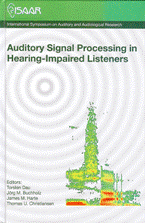Spatial unmasking in aided hearing-impaired listeners and the need for training
Abstract
Even though spatial unmasking (SU) in hearing-impaired subjects has been the subject of a number of studies, very little research seems to have been carried out under aided conditions, especially not for more complex speech-on-speech masking situations. As part of an earlier pilot study into aided SU, a group of test subjects were found to exhibit substantial training effects across different visits, despite some initial training. A new training program was therefore designed based on some ndings from the perceptual learning and training literature. Nine elderly hearing-aid users with mild-to-moderate, sloping hearing losses were systematically trained in a speech-on-speech SU task. All subjects were bilaterally tted and only tested with their own hearing aids. Using a new speech corpus suitable for speech-on-speech SU assessment, performance was then determined at two subsequent visits. Whilst there were substantial differences between test subjects, half of them showed SU as large as 10 dB. Moreover, performance across the two visits was found to be much more stable. These results hint at the need for thorough training when elderly hearing-aid users are to be tested under complex listening conditions.
References
Bronkhorst, A. W. (2000). “The cocktail party phenomenon: A review of research on speech intelligibility in multiple-talker conditions,” Acta Acust. Acust. 86, 117-128.
Durlach, N. I., Thompson, C. L., and Colburn, H. S. (1981). “Binaural interaction in impaired listeners: A review of past research,” Audiol. 20, 181-211.
Kalluri, S., and Edwards, B. (2007), “Impact of hearing impairment and hearing aids on bene ts due to binaural hearing,” 19th International Congress on Acoustics, Madrid, Spain, Sept. 2-7.
Marrone, N. L., Mason, C. R., and Kidd, G. Jr. (2007). “Spatial release from speech-on-speech masking in adult hearing aid users,” 153rd Meeting of the Acoustical Society of America, Salt Lake City, Utah, June 4-8.
Middlebrooks, J. C., and Green, D. M. (1991). “Sound localization by human listeners,” Ann. Rev. Psychol. 42, 135-159.
Ortiz, J. A., and Wright, B. A. (2005). “Effects of different amounts of brief training and rest on the generalization of learning from interaural-level-difference to inter- aural-time-difference discrimination,” J. Acoust. Soc. Am. 117, 2561.
Sweetow, R. and Palmer, C. V. (2005). “Efficacy of individual auditory training in adults: A systematic review of the evidence,” J. Am. Acad. Audiol. 16, 494-504.
Wagener, K., Josvassen, J. L., and Ardenkjær, R. (2003), “Design, evaluation and optimization of a Danish sentence test in noise,” Int. J. Audiol. 42, 10-17.
Wightman, F. L., and Kistler, D. J. (1992). “The dominant role of low-frequency interaural time differences in sound localization,” J. Acoust. Soc. Am. 91, 1648-1661.
Additional Files
Published
How to Cite
Issue
Section
License
Authors who publish with this journal agree to the following terms:
a. Authors retain copyright* and grant the journal right of first publication with the work simultaneously licensed under a Creative Commons Attribution License that allows others to share the work with an acknowledgement of the work's authorship and initial publication in this journal.
b. Authors are able to enter into separate, additional contractual arrangements for the non-exclusive distribution of the journal's published version of the work (e.g., post it to an institutional repository or publish it in a book), with an acknowledgement of its initial publication in this journal.
c. Authors are permitted and encouraged to post their work online (e.g., in institutional repositories or on their website) prior to and during the submission process, as it can lead to productive exchanges, as well as earlier and greater citation of published work (See The Effect of Open Access).
*From the 2017 issue onward. The Danavox Jubilee Foundation owns the copyright of all articles published in the 1969-2015 issues. However, authors are still allowed to share the work with an acknowledgement of the work's authorship and initial publication in this journal.


